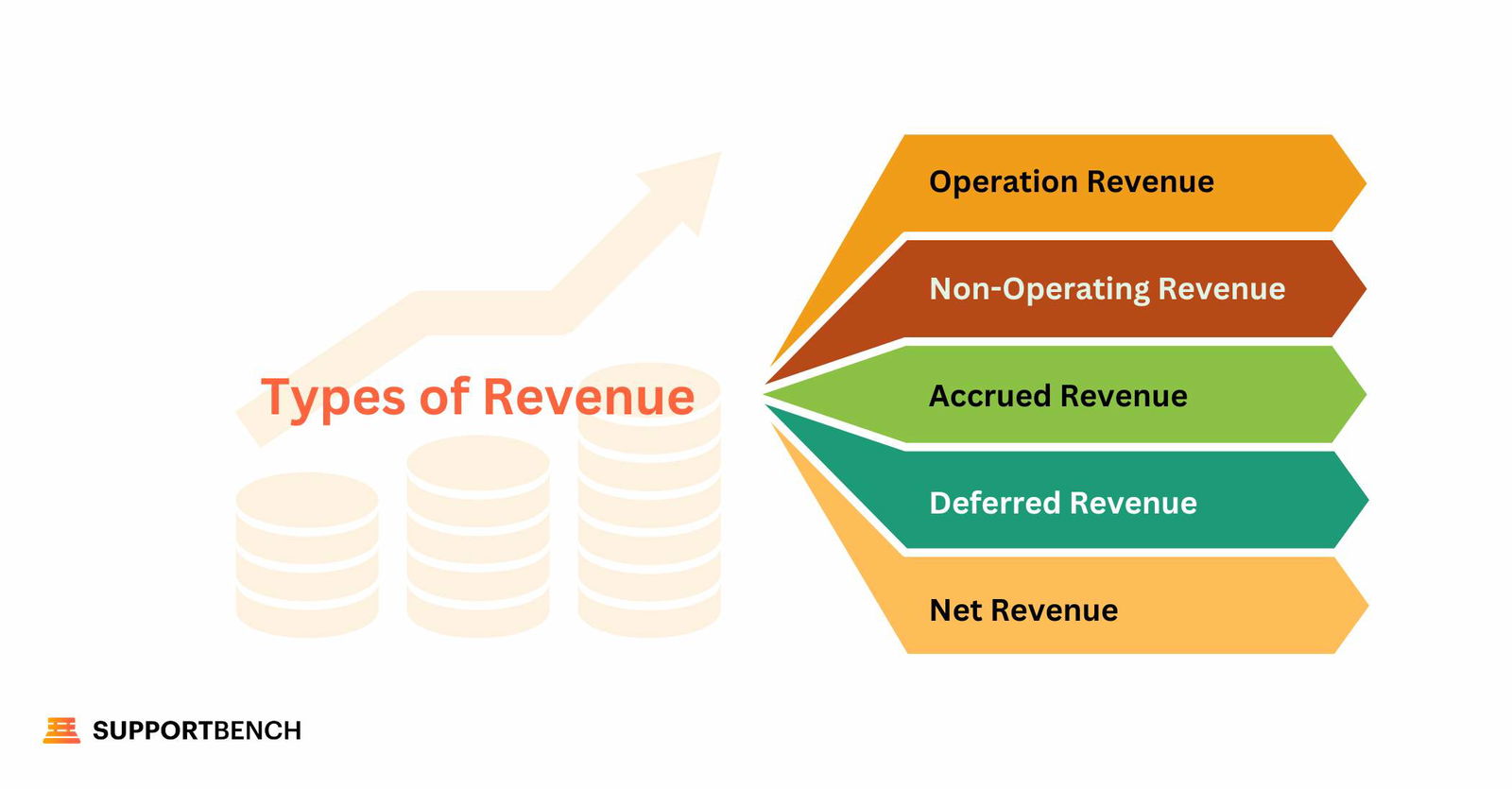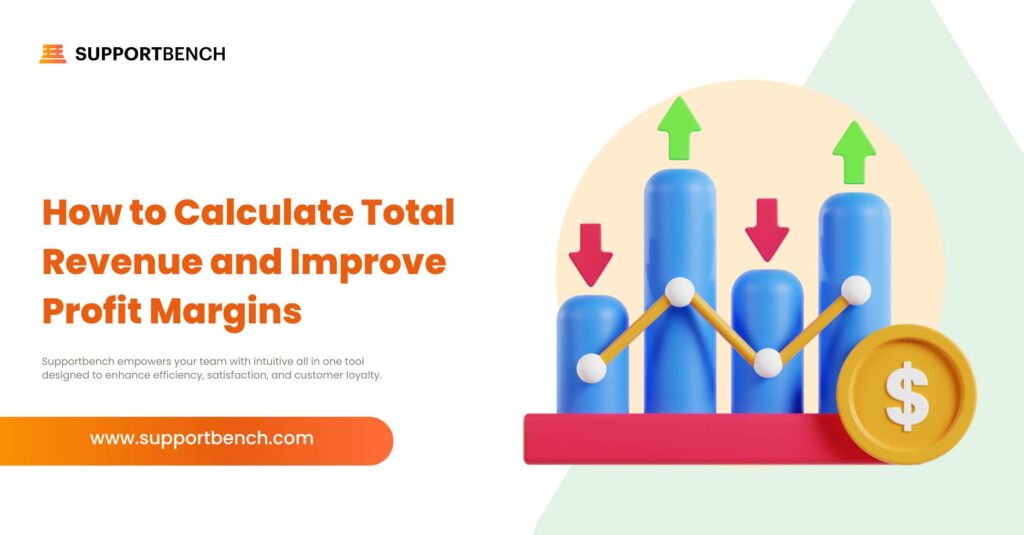Total revenue is a key metric that reflects income from the sale of goods or services. It needs to be tracked to ensure the proper enhancement of the company’s operations, such as those using the Supportbench customer support platform, where insight into how to find and analyze total revenue becomes critical.
Accurately measuring the total revenue provides a firm with the right insights to make decisions related to price strategies, customers, and overall growth potential.
What is Total Revenue?
Total revenue, otherwise known as total sales or gross revenue, is the total sum of money generated by your enterprise before expenses are taken into account. Sometimes, it can also include interest and dividends from investments.
Simply put, higher total revenue means your company is making more money. If total revenue drops, there may be problems with your sales strategies or pricing. You can use total revenue to:
- Assess your business’s financial health
- Identify problem areas
- Adjust your pricing
You can find total revenue on your income statement, which shows your company’s profits and losses over a specific time. Total revenue usually appears as a separate line on this statement.

How to Calculate Total Revenue?
Follow these steps for how to calculate total revenue:
Select Fiscal Period
To start, you need to select a particular period of time in which you want to calculate total revenue. This helps analyze how many products were sold or services rendered, and it also provides a platform for comparing financial growth across different durations. The fiscal period could be a month, a quarter, a year, etc. It would be important to choose a fiscal period for the sake of performance comparison. For example, you can look at a company’s total revenue over two years to see if it has improved.
Determine the Total Units Sold
After selecting the fiscal period you are looking at, find out the amount of the units that were sold during the period in question. You may have to refer back to your invoicing and records. If your business is in services, count the total subscriptions or billable hours to determine the total units of sales.
Calculate the Average Unit Cost of Sales
When calculating gross revenue, consider the selling price of your products within the selected fiscal period. This will enable you to compare gross revenue before and after any changes in the selling price. In case you provided some discounts or bonuses, you should first find the average price of your products.
Multiply Units by Average Price
To calculate total revenue, use the formula TR = Q x P, where TR is Total Revenue, Q is Quantity, and P is Price. Multiply the number of units sold by the average price to find total revenue. For example, if your fruit drink business sells 700 bottles at $3.50 each during a given month, the total revenue for that month is 700 x $3.50, which equals $2,450.
For a deeper understanding of your revenue, you can also calculate the average revenue per user. These formulas help you see a clearer picture of your business income and improve revenue management.
Total Revenue Examples
Retail Store Revenue:
If your company is selling clothes for example, here’s how to calculate total revenue. Suppose you sell 10 dresses for $50 each and 15 skirts for $20 each. To find the total revenue, multiply 10 by $50 and 15 by $20 then add both the amounts. The total revenue is $800.
Total Revenue = 10 x $50 + 15 x $20 = $800
Consulting Services Revenue:
If your business is a consulting business, use your hourly rate to figure revenues. Think of each hour you work as a product sold. If you charge $50 an hour and work 10 hours for one company and 15 hours for another, multiply your hourly rate by the hours worked and then add the totals. The total revenue in this example is $1,250.
TR = (10 x $50) + (15 x $50) = $1,250

Tips to Increase and Improve Total Revenue
Increasing revenue boosts profit and lets you reinvest in your business and grow. Higher revenue shows that a business is financially healthy. Whether you want to expand or just improve sales, here are tips to help you increase your revenue.
Grow Your Customer Base
An expanding customer base means revenue will grow. Understand your targeted customer base to enhance your sales team’s ability to reach them most effectively. Expansion into another location, or offering services in another area, is one good way to grow the customer base.
This may also be done effectively through online advertising focused on your target customers. Also consider social media post development, the execution of targeted ad campaigns, and special promotions for new customers online.
Set Defined Goals
Set clear goals for increasing your sales and revenue. This helps you plan how to reach those goals and choose the right methods. You can also use these goals to motivate yourself and your sales team by tracking your progress.
Refine Your Pricing Strategy
Effective pricing strategies involve an optimization process. If the price is too high, you will lose customers; if it is too low, you will not make much profit. Which pricing strategy to choose depends on the marketplace, your products, and customers.
For example, if the marketplace is pretty competitive with similar kinds of products, you probably want to lower the prices to win more customers. If you have a product in which customers find uniqueness and value, you can offer higher prices due to brand loyalty. You can balance this out with promotions and discounts that attract new customers without changing your long-term pricing.
Target Repeat and Former Customers
Nurture your loyal customers to be even better customers. You can communicate with them more regularly in order to remind them about your store and inform them of key updates.
You can also email or text them when you are having special sales, or when new products arrive. Most of the email tools out there will give you open rates-click through rates so that you may understand how effective your messages are.
It is often easier to reach out to former customers than to find new ones. You needs to develop a marketing plan for them. Give special incentives, such as discounts for trading in old items when they buy new. Former customers provide referrals or reviews that attract new customers.
Add New Payment Methods
You can boost sales by providing new payment forms that customers prefer. Look at what payment options top companies in your industry use. Then, set up the systems to accept any payment methods you don’t already have, like credit cards, cash exchange apps, or secure quick pay options, such as digital wallets or payment apps.
Expand Product/Service Offerings
The development of a wider range of products will surely help you differentiate yourself from competition and reinforce customer loyalty. First, do some market research and get to know your customers better.
See what your competitors are offering, and ask for feedback on what your customers want. Promote new products to enhance your current offerings. Once you have diversified your product mix, offer trials or discounts so customers can try your new products.
Types of Revenue
There are various forms of revenue calculation that are important to your sales role, including:

Operating Revenue
Operating revenue refers to the income generated from a company’s core business activities. It is often the largest source of income, typically tied to the key products or services the company offers.
For example, a consulting firm’s operating revenue would come from client subscriptions, retainer fees, and income earned from direct services provided to clients.
This type of revenue helps show a business’s profitability by separating it from costs related to non-core activities. It gives a better understanding of the actual financial health of the company and to what extent growth is tracked, such as increases in sales.
Non-Operating Revenue
Non-operating revenue refers to income generated from activities that are outside a company’s core business operations, such as investments or one-time transactions. It is generally less frequent and should be kept separate from operating revenue when calculating sales, as it does not reflect the company’s primary business performance.
As an example, a private college may receive donations or gifts from alumn, and that could be classified as a non-operating revenue.
Accrued Revenue
Accrued revenue refers to income a company has earned by providing products or services, even if payment has not yet been received. Under the accrual accounting principle, revenue is recognized when it is earned, rather than when cash is collected.
Under Generally Accepted Accounting Principles (GAAP), revenues are recognized when the product or service is delivered. What that means, in simple terms, is that if you have a long-term contract with your customer, under GAAP you would record accrued revenue at the time the product was provided-even if the payment came later.
Deferred Revenue
The deferred revenues are the monies that have been received prior to the delivery of merchandise or even the rendering of services. It usually assists a business in accountancy for those revenues that have not been earned yet. When it comes to accounting for the deferred revenues, this should be reflected on the balance sheet as a form of liability.
Computation of this represents what the business owes from its customers regarding future obligations. It contacts with accrued revenue, which is used to track the income that is anticipated. The account for deferred revenue observes standards of GAAP concerning conservative accounting.
Net Revenue
Net revenue is a key metric used to assess the profitability of sales by deducting components such as discounts, refunds, and fees from the total revenue. It helps determine the effectiveness of your sales strategies. For instance, net revenue can reveal how much you are discounting items and how those reductions impact overall sales. For example, if the price of an item drops from $10 to $8.50, the calculation will reflect the $1.50 discount and demonstrate how it could drive higher sales volume.
Conclusion
Understanding total revenue and how to calculate it is absolutely essential for running a data-driven business decision and optimizing your growth strategies. The comprehension of this basic concept will allow companies to effectively establish their pricing model, measure the effectiveness of sales, and predict future performance.
For businesses using platforms like Supportbench, improving customer support through better workflow automation and proactive insights not only enhances customer satisfaction but can directly contribute to revenue growth. By leveraging these tools, businesses can noticeably strengthen their customer relationships while maximizing their total revenue potential.
FAQs
1. How do I find total revenue on an income statement?
Revenue can come from various sources, such as lawsuit winnings, investment dividends, and donations. You can typically find the total revenue at the top of an income statement, before the company lists any expenses.
2. What is an example of total revenue?
Your business sells 10 dresses for $50 each and 15 skirts for $20 each. To find the total revenue, multiply 10 by $50 and 15 by $20, then add the two amounts together.
3. How does total revenue differ from net revenue?
Total revenue represents all income generated from sales and other sources, whereas net revenue is total revenue minus deductions like discounts, refunds, and fees.












